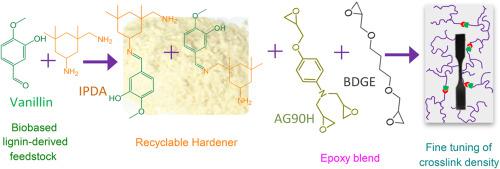Materials Today Communications ( IF 3.8 ) Pub Date : 2021-09-20 , DOI: 10.1016/j.mtcomm.2021.102814 Hafeezullah Memon 1 , Yi Wei 2, 3 , Chengyan Zhu 1

|
Vitrimers have covalent crosslink structures as normal thermoset polymers, but they possess unique properties of being able to go through plastic deformation due to their crosslinks being dynamically exchangeable above a particular temperature. This new type of polymers is getting increased attention owing to their reprocessing, remolding, and recycling properties, along with the thermoset characteristics. As a thermoset, the materials’ degree of crosslinking, namely crosslink density, is essential to their physical and mechanical properties. Herein, a series of dynamic epoxy crosslinking networks with different crosslink densities were prepared by changing the ratio of two epoxies N,N-diglycidyl-4-glycidyloxyaniline, and butanediol diglycidyl ether but keeping the same stoichiometric ratios when cured with a hardener synthesized from bio-based lignin-derived vanillin. The reaction enthalpy (ΔH) and glass transition temperature (Tg) were shown to decrease with decreasing crosslink density. The dynamic behavior of the resins was attributed to the dynamically exchangeable imine bonds brought in by the curing agent. The dynamic properties under various temperatures were analyzed to determine the activation energy for bond exchange (Ea) and relaxation times (τ). The results revealed that the resin with the highest crosslink density showed the highest τ as well as the highest Ea. The resins with higher crosslink density showed higher mechanical and thermal properties but lower strength retention efficiency (SRE). This study provides important insights into understanding the properties of this bio-based epoxy vitrimer.
中文翻译:

将新型生物基环氧玻璃体的热机械性能与其交联密度相关联
Vitrimers 具有与普通热固性聚合物一样的共价交联结构,但由于它们的交联在特定温度以上可动态交换,因此它们具有能够经历塑性变形的独特性质。这种新型聚合物由于其再加工、再成型和回收特性以及热固性特性而受到越来越多的关注。作为热固性材料,材料的交联度,即交联密度,对其物理和机械性能至关重要。在此,通过改变两种环氧树脂 N,N-二缩水甘油基-4-缩水甘油氧基苯胺的比例,制备了一系列具有不同交联密度的动态环氧树脂交联网络,和丁二醇二缩水甘油醚,但在使用由生物基木质素衍生的香草醛合成的硬化剂固化时保持相同的化学计量比。反应焓(ΔH)和玻璃化转变温度(T g ) 显示出随着交联密度的降低而降低。树脂的动态行为归因于固化剂带来的动态可交换亚胺键。分析了不同温度下的动态特性,以确定键交换的活化能 ( E a ) 和弛豫时间 ( τ )。结果表明,具有最高交联密度的树脂表现出最高的τ和最高的E a. 具有较高交联密度的树脂表现出较高的机械和热性能,但强度保持效率 (SRE) 较低。这项研究为理解这种生物基环氧玻璃体的特性提供了重要的见解。



























 京公网安备 11010802027423号
京公网安备 11010802027423号